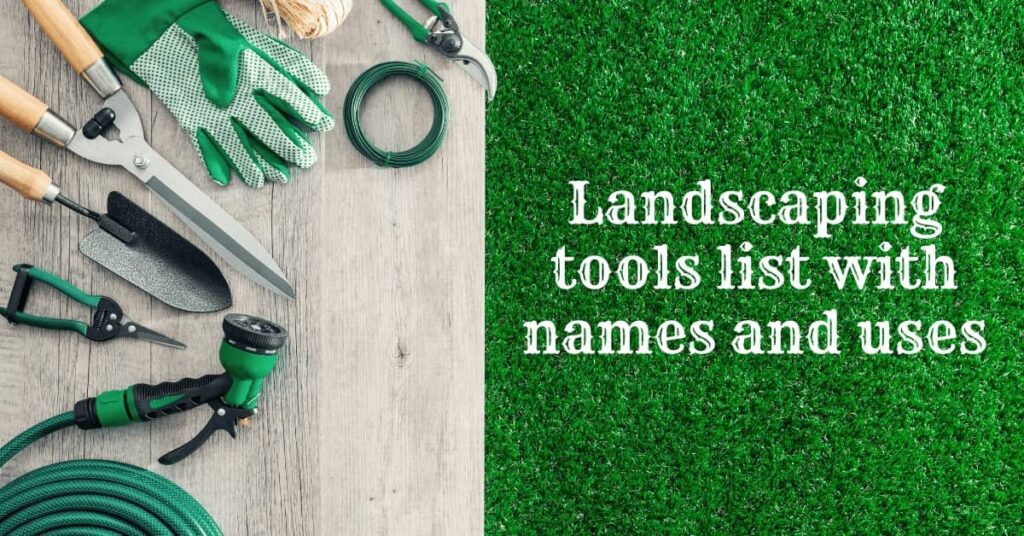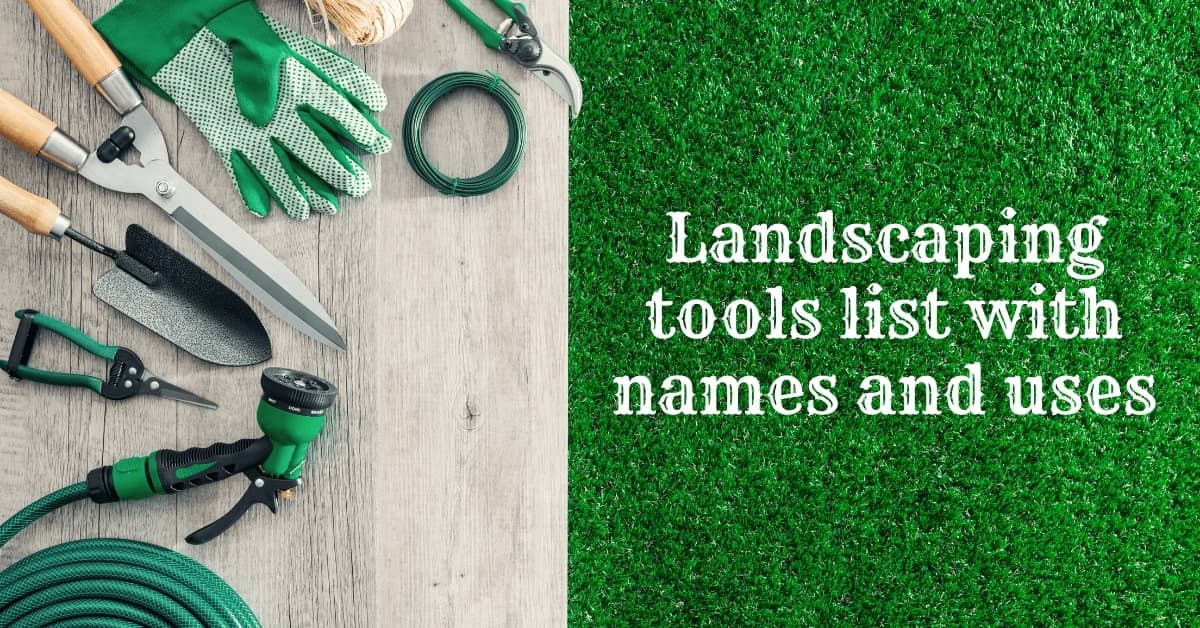
Essential Landscaping Tools: A Comprehensive Guide for Homeowners
Landscaping is more than just mowing the lawn; it’s about creating a beautiful and functional outdoor space. Whether you’re a seasoned gardener or a weekend warrior, having the right landscaping tools is crucial for achieving your desired results. This guide provides a comprehensive overview of essential landscaping tools, helping you choose the best equipment for your needs and budget. Understanding the function and proper use of each tool will not only improve your landscaping efforts but also ensure your safety and the longevity of your equipment. Let’s dive in and explore the world of landscaping tools.
The Core Landscaping Tools: Essentials for Every Gardener
Certain landscaping tools are fundamental to nearly every gardening task. These are the tools you’ll reach for most often, and investing in quality versions will pay off in the long run.
Shovels: Digging Deep
A good shovel is the workhorse of any landscaping arsenal. Look for a shovel with a sturdy handle and a sharp blade. There are different types of shovels, each designed for specific tasks:
- Round-point shovels: Ideal for digging holes, moving soil, and general landscaping work.
- Square-point shovels: Best for edging, scooping materials like mulch or gravel, and cleaning up.
Rakes: Leveling and Clearing
Rakes are essential for leveling soil, gathering leaves, and removing debris. Consider these rake types:
- Leaf rakes: Designed with flexible tines to gather leaves and grass clippings without damaging the lawn.
- Bow rakes: Sturdier than leaf rakes, bow rakes are used for leveling soil, spreading mulch, and removing stones.
Trowels: Planting and Weeding
A trowel is a small hand tool used for planting seedlings, transplanting flowers, and weeding. Choose a trowel with a comfortable grip and a durable blade.
Hand Pruners: Trimming and Shaping
Hand pruners are essential for trimming small branches, deadheading flowers, and shaping shrubs. Bypass pruners, which have two blades that pass each other like scissors, are generally preferred over anvil pruners, which crush the stem.
Garden Hose and Sprinkler: Watering Wisely
A reliable garden hose and sprinkler system are crucial for keeping your plants hydrated. Consider a soaker hose for efficient watering of garden beds, and an adjustable sprinkler for covering larger areas of the lawn. [See also: Choosing the Right Sprinkler System]
Power Landscaping Tools: Tackling Larger Projects
For larger landscaping projects, power tools can save you time and effort. While they require a greater initial investment, they can significantly increase your productivity.
Lawn Mowers: Maintaining a Healthy Lawn
A lawn mower is essential for maintaining a healthy and attractive lawn. There are several types of lawn mowers to choose from, including:
- Push mowers: Ideal for small lawns and those who prefer a manual approach.
- Gas-powered mowers: Powerful and efficient, suitable for medium to large lawns.
- Electric mowers: Environmentally friendly and quieter than gas-powered mowers, best for small to medium lawns.
- Riding mowers: Designed for large lawns, riding mowers offer comfort and efficiency.
String Trimmers: Edging and Trimming
String trimmers, also known as weed eaters, are used for trimming grass and weeds in hard-to-reach areas, such as along fences, sidewalks, and garden beds. Consider both gas-powered and electric models.
Leaf Blowers: Clearing Debris Quickly
Leaf blowers are useful for quickly clearing leaves, grass clippings, and other debris from your lawn and garden. Choose between handheld and backpack models, depending on the size of your property and the amount of debris you need to clear.
Hedge Trimmers: Shaping Hedges and Shrubs
Hedge trimmers are specifically designed for shaping hedges and shrubs. They come in both gas-powered and electric models, and it’s important to select a model with a blade length appropriate for the size of your hedges. Regular use of hedge trimmers keeps your landscaping tidy and well-maintained.
Chainsaws: Cutting Branches and Trees
A chainsaw is a powerful tool used for cutting branches, felling trees, and pruning large shrubs. Chainsaws require careful operation and safety precautions. [See also: Chainsaw Safety Tips]
Specialty Landscaping Tools: For Specific Tasks
Certain landscaping tools are designed for specific tasks, such as edging, aerating, and transplanting. While not essential for every gardener, these tools can be invaluable for certain projects.
Edgers: Creating Clean Lines
Edgers are used to create clean, defined lines between your lawn and garden beds or sidewalks. A sharp edger can dramatically improve the appearance of your landscaping.
Aerators: Improving Soil Health
Aerators are used to create small holes in the soil, allowing air, water, and nutrients to reach the roots of your plants. Aerating your lawn can improve soil health and promote healthy grass growth.
Post Hole Diggers: Installing Fences and Posts
Post hole diggers are used to dig holes for fence posts, signposts, and other landscaping structures. There are two main types of post hole diggers: manual and powered. [See also: Installing a Fence: A Step-by-Step Guide]
Wheelbarrows: Moving Materials Easily
Wheelbarrows make moving heavy materials like soil, mulch, and rocks much easier. Choose a wheelbarrow with a durable frame and a large capacity.
Soil Testers: Understanding Your Soil
A soil tester can help you determine the pH level and nutrient content of your soil. This information is essential for choosing the right plants and fertilizers for your garden.
Choosing the Right Landscaping Tools: Factors to Consider
When choosing landscaping tools, consider the following factors:
- Quality: Invest in high-quality tools that will last for years.
- Comfort: Choose tools with comfortable grips and ergonomic designs.
- Size and weight: Select tools that are appropriate for your size and strength.
- Budget: Set a budget and stick to it.
- Storage: Consider where you will store your tools when they are not in use.
Maintaining Your Landscaping Tools: Ensuring Longevity
Proper maintenance is essential for ensuring the longevity of your landscaping tools. Here are some tips:
- Clean your tools after each use. Remove soil, debris, and moisture to prevent rust and corrosion.
- Sharpen your blades regularly. Sharp blades make it easier to cut and reduce strain on your tools.
- Lubricate moving parts. Use a lubricant to keep moving parts functioning smoothly.
- Store your tools properly. Store your tools in a dry, protected location to prevent damage.
Safety Tips for Using Landscaping Tools
Safety should always be your top priority when using landscaping tools. Here are some safety tips:
- Wear appropriate safety gear. Wear gloves, eye protection, and hearing protection when using power tools.
- Read the manufacturer’s instructions. Before using any tool, read and understand the manufacturer’s instructions.
- Be aware of your surroundings. Be aware of people, pets, and obstacles in your work area.
- Use the right tool for the job. Using the wrong tool can be dangerous and can damage your tools.
- Take breaks. Avoid overexertion by taking breaks when necessary.
Investing in Quality Landscaping Tools for a Beautiful Outdoor Space
Having the right landscaping tools is essential for creating and maintaining a beautiful outdoor space. By investing in quality tools, following proper maintenance procedures, and prioritizing safety, you can enjoy your landscaping projects for years to come. From basic hand tools to powerful machinery, understanding the purpose and proper use of each tool will empower you to transform your yard into a stunning oasis. So, get equipped, get out there, and get landscaping!
Remember to always prioritize safety when operating any landscaping tools. Regular maintenance will extend the life of your investments, and the right tool can make all the difference in achieving the landscape of your dreams. Whether you’re tending to a small garden or managing a large property, the right landscaping tools are your partners in creating a beautiful and thriving outdoor environment.

